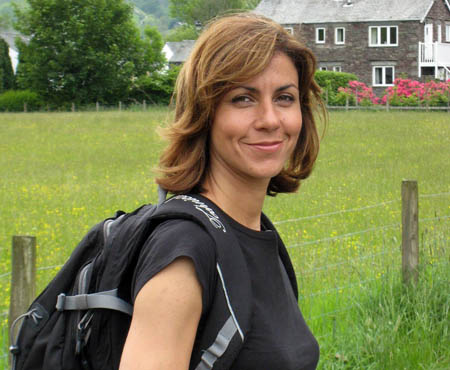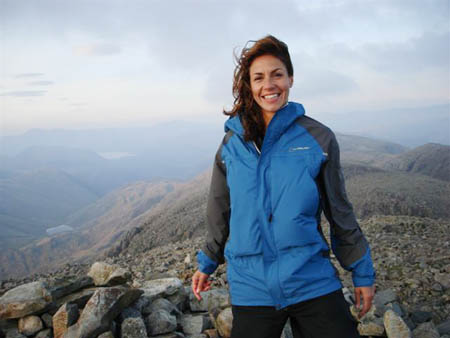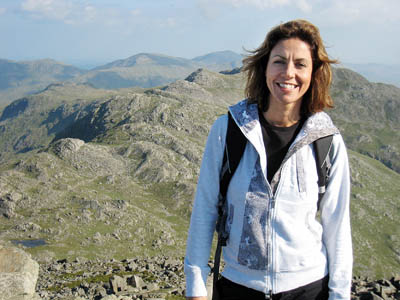
Julia Bradbury
She’s become the pin-up of walkers across the country yet she’s been blamed for increasing the workload of mountain rescue teams across the Lake District.
Julia Bradbury has brought the Lakeland fells to the attention of a wider public with her BBC series of walks based on Alfred Wainwright’s guides. She has also tackled a petrifying climb on a Scottish sea stack and pursued the more gentle tracks of disused railways from the south coast of England to the Scottish Highlands.
grough asked Ms Bradbury for an insight into what made her take to the fells. The Dublin-born television presenter undertook some serious mountain terrain during the filming of Wainwright’s Walks, including the infamous Sharp Edge on Blencathra, the difficult arête above Scales Tarn which was the scene of a family tragedy earlier this year when a fall killed 38-year-old Emma Anderson and left her husband and daughter hospitalised.
Julia also scaled England’s highest mountain Scafell Pike and Helvellyn via Striding Edge, neither of which are easy prospects. So how much experience did the 36-year-old have of serious walking before she started filming Wainwright’s Walks?
“I have been walking, hiking and rambling with my dad, who’s a Derbyshire lad, since I was six years old,” she said.
“Our early terrain was the Peak District. We lived in Sheffield throughout my teens and would disappear into the dales whenever we could, tackling the rugged landscape and tickling trout – real father-daughter bonding times.
“I asked Dad about those early days during an interview with him on my recent Railway Walks series and he said: ‘Touching your first trout gently under the gills is like touching your first woman: smooth, soft, sometimes slippery but very exciting.’”
Wainwright’s Walks was credited with increasing the popularity of the routes covered in the two series. grough asked Julia if she thought this was a good thing. She told us: “There’s obviously a fine balance between encouraging people to get out there and drowning a particular route in a sea of ramblers.

Julia on the Lakeland fell tops
“It’s only natural that the initial response to various beautiful routes would be enthusiastic, but I hope the viewers embrace the ethos of the programmes, which is that everyone has their own particular favourites and the best walk of all is one that you discover.”
Some in the walking community, including mountain rescue team members, attributed a rise in the number of people calling for help from the Lake District fells to the portrayal of the Cumbrian mountains in the BBC series. How did she answer the criticism of Wainwright’s Walks that it didn’t emphasise enough the challenging nature and potential danger of fellwalking?
“These are programmes for people’s enjoyment and entertainment. They are not health-and-safety messages about how to hike. I often drink water, get my OS maps out etc.”
Julia said the question she is asked most about Wainwright’s Walks is: did you get airlifted off the summits?
Her answer is emphatic: “No. No helicopters. Only when the beautiful aerial shots are being executed. We take shorter routes on the way down.”
Each Wainwright episode took two or three days to get in the can, depending on the difficulty of walk and the weather.
“It’s quite hard work with all the equipment and the whole team are very fit,” Julia said.
Griff Rhys Jones admitted he only made it halfway up the rock climb of Napes Needle on Great Gable when he shot his Mountain series. Viewers of Ultimate Rock Climb, however, will have seen Ms Bradbury triumph on the Old Man of Stoer, a 60m-high stack of sandstone off the Sutherland coast.

Tackling the Old Man or Stoer
The Very Severe-rated route had Julia in tears, despite encouragement from her climbing partner Tim Emmett. What was going through her mind when she was tackling the climb?
“It was an absolute mind over matter test for me,” she told us. “I was determined to make it to the top and in those many moments of great fear I focused on the fact that it was a mental challenge and physically possible. When I stopped crying that is.
“I’m proud to have made it to the top and will remember that feeling always.”
Her climbing exploits also included Crackstone Rib in the Llanberis Pass and Commando Ridge in Cornwall. So she’s no slouch when it comes to physical challenges. It should therefore have surprised no-one when she decided to take on the Grumpy OId Fellwalker’s ultimate long-distance route: the Coast to Coast.
Did she do any training for the 192-mile slog from St Bees to Robin Hood’s Bay? “I’m naturally quite fit,” she said, “And have spent the summer working on another series of the Rough Guide holiday strand for Channel 5, including an Ultimate series which included lots of activities like hiking through the Siberut jungle, abseiling, para-gliding, rock climbing and bungee jumping.
“So I was pretty fit by the time it came to shoot the Coast to Coast. We covered the 192 miles in about three weeks.”

Following in the footsteps of Wainwright on Bowfell
And before any smug Coast-to-Coasters snort that’s a long time to take, imagine the retracing of steps, the multiple takes, the interviews and all the rest that go with producing a film of such a subject. Anyone who has witnessed a television crew at work will realise that that is a fairly swift pace for producing six episodes.
We all have our reasons for taking to the hills. What is Julia’s favourite aspect of fellwalking? “Drowning in the beauty of a view; the fresh air on your cheeks; the burn in your legs, and the bubble of excitement that every summit evokes,” is her reply.
Four good reasons to follow in the footsteps of a man who, frankly, might have disapproved of a woman fronting his routes on television. He was, after all, quite dismissive of the female on the fells. All power to the Gore-tex clad action woman for proving that women can do it just as well, if not better. Wainwright, after all, never summited the Howitzer top of Helm Crag.
So what else is in the pipeline for the queen of the outdoors? What plans are afoot? “They are top secret,” she told us, “but I think some of grough’s readers will enjoy them.”
Railway Walks is currently being repeated on BBC4. The Wainwright Coast-to-Coast series will screen in spring next year. For grough’s view of the route and an account of our venture, check out our Sea to Sea: we follow Wainwright from Coast to Coast.
Julia Bradbury’s official site has biographical details.
SilverFox
21 November 2008Just the job! She is the walking pin up, not just in looks but attitude also. Very intersting and informative on the background to Julia's walks.
PS How do i remove my e-mail address from my profile. I am conscious i do not wish unprovoked mail
TVM
Patrick
Iain Cairns
19 December 2008A Mountain has to appear pointed I.E. Cnicht, Tryfan and Roseberry Topping it is the simple law of aesthetics, if it is not pointed it is a pap as in Glencoe. So the Howgills are Paps. Lets face it if you are that sad that you now want to walk up a hill because it is is two feet higher than you thought best start wearing GAP or something else with a BIG name on it. I wonder how many people bother to walk up Yr Aran on the way to the top of Yr Wyddfa (from Pont Bethania) no time and it is not over 3000ft! I reckon the Mountains, paps etc get all these names (Munros etc) as some sort of memorial, bit like the the White Horse in North Yorkshire which in reality just a bit of Victorian graffiti so a teacher could be remembered, if it had been a pupil he would have been sent to Australia. Forget the numbers and names go for the beauty.
Paul
11 January 2009Pap is a Gaelic word so I'm not sure if it applies south of the border. I always thought that anything over 600m was called a mountain, not just any old pointy hill.
Russ Brown
27 January 2009Julia and I will be competing in the Mac 4x4 in March in aid of Macmillan Cancer Support, if you would like to sponsor us our JG page is at http://www.justgiving.com/mac4x4juliabradbury
For more info about the event and our press relaease see http://www.mac4x4.co.uk/
Thanks in advance.....
peter wood
17 February 2009“These are programmes for people’s enjoyment and entertainment. They are not health-and-safety messages about how to hike". Julia's answer to your point about safety is a cop-out. There was - and is - an argument for quietly pointing out that you do need to be reasonably competent to enjoy the fells. I suggested some time ago that a safety notice - nothing stuffy - but lively and helpful - could be inserted in every Wainwright guide sold. Your own website news reports on accidents and the missing underline the case very well.
Ian Hickling
17 February 2010I believe that if we took all the Health and Safety notices off, the problem would sort itself out quite quickly.
Pap, by the way is, is an old word for breast or nipple - hence its use for a peak with that type of shape!
That remark was not intended to bring the conversation back to the lovely Julia!